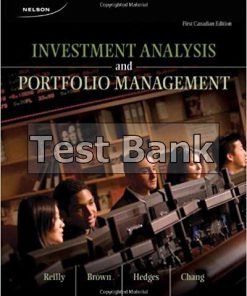Analysis of Investments and Management of Portfolios 1st Edition Reilly Test Bank
$26.50$50.00 (-47%)
Analysis of Investments and Management of Portfolios 1st Edition Reilly Test Bank.
You may also like
Analysis of Investments and Management of Portfolios 1st Edition Reilly Test Bank

Product details:
- ISBN-10 : 9788131518748
- ISBN-13 : 978-8131518748
- Author:
This title teaches readers how to manage their money in order to maximize earning potential. From asset allocation to selective investments in a global market, this book gives readers a solid foundation in personal finance and presents the same tools used extensively by professionals, organizations and schools across the country.
Table contents:
- Part I: The Investment Background
- Ch 1: The Investment Process
- Ch 1: Learning Objectives
- Ch 1: Introduction
- 1.1: What Is an Investment?
- 1.2: Measures of Return and Risk
- 1.3: Determinants of Required Rates of Return
- 1.4: Relationship Between Risk and Return
- Ch 1: Summary
- Ch 1: Suggested Readings
- Ch 1: Questions
- Ch 1: Problems
- Ch 1: Notes
- Ch 2: The Global Market Investment Decision
- Ch 2: Learning Objectives
- Ch 2: Introduction
- 2.1: The Case for Global Investments
- 2.2: Global Investment Choices
- 2.3: Historical Risk-Returns on Alternative Investments
- Ch 2: Summary
- Ch 2: Suggested Readings
- Ch 2: Questions
- Ch 2: Problems
- Ch 2: Notes
- Ch 3: Securities Markets: Organisation and Operation
- Ch 3: Learning Objectives
- Ch 3: Introduction
- 3.1: What is a Market?
- 3.2: Primary Capital Markets
- 3.3: Secondary Financial Markets
- 3.4: Classification of Secondary Equity Markets
- 3.5: Alternative Types of Orders Available
- Ch 3: Summary
- Ch 3: Suggested Readings
- Ch 3: Questions
- Ch 3: Problems
- Ch 3: Notes
- Part II: Developments in Investment Theory
- Ch 4: Efficient Capital Markets
- Ch 4: Learning Objectives
- Ch 4: Introduction
- 4.1: Why Should Capital Markets Be Efficient?
- 4.2: Alternative Efficient Market Hypotheses
- 4.3: Tests and Results of Efficient Market Hypotheses
- 4.4: Behavioural Finance
- 4.5: Implications of Efficient Capital Markets
- Ch 4: Summary
- Ch 4: Suggested Readings
- Ch 4: Questions
- Ch 4: Problems
- Ch 4: Notes
- Ch 5: Portfolio Management
- Ch 5: Learning Objectives
- Ch 5: Introduction
- 5.1: Some Background Assumptions
- 5.2: Markowitz Portfolio Theory
- Ch 5: Summary
- Ch 5: Suggested Readings
- Ch 5: Questions
- Ch 5: Problems
- Ch 5: Notes
- Ch 6: Asset Pricing Models
- Ch 6: Learning Objectives
- Ch 6: Introduction
- 6.1: Capital Market Theory: An Overview
- 6.2: The Capital Asset Pricing Model
- 6.3: Relaxing the Assumptions
- 6.4: Additional Empirical Test of the CAPM
- 6.5: The Market Portfolio: Theory versus Practice
- Ch 6: Summary
- Ch 6: Suggested Readings
- Ch 6: Questions
- Ch 6: Problems
- Ch 6: Notes
- Ch 7: Multifactor Models of Risk and Return
- Ch 7: Learning Objectives
- Ch 7: Introduction
- 7.1: Arbitrage Pricing Theory
- 7.2: Multifactor Models and Risk Estimation
- Ch 7: Summary
- Ch 7: Suggested Readings
- Ch 7: Questions
- Ch 7: Problems
- Ch 7: Notes
- Part III: Valuation Principles and Practices
- Ch 8: Analysis of Financial Statements
- Ch 8: Learning Objectives
- Ch 8: Introduction
- 8.1: Major Financial Statements
- 8.2: Analysis of Financial Ratios
- 8.3: Computation of Financial Ratios
- 8.4: Evaluating Internal Liquidity
- 8.5: Evaluating Operating Performance
- 8.6: Risk Analysis
- 8.7: Analysis of Growth Potential
- 8.8: Comparative Analysis of Ratios
- 8.9: The Quality of Financial Statements
- 8.10: The Value of Financial Statement Analysis
- 8.11: Specific Uses of Financial Ratios
- Ch 8: Summary
- Ch 8: Suggested Readings
- Ch 8: Questions
- Ch 8: Problems
- Ch 8: Notes
- Ch 9: Security Valuation Principles
- Ch 9: Learning Objectives
- Ch 9: Introduction
- 9.1: An Overview of the Valuation Process
- 9.2: Why a Three-Step Valuation Process?
- 9.3: Theory of Valuation
- 9.4: Valuation of Alternative Investments
- 9.5: Relative Valuation Techniques
- 9.6: Estimating the Inputs: The Required Rate of Return and the Expected Growth Rate of Valuation Va
- Ch 9: Summary
- Ch 9: Suggested Readings
- Ch 9: Questions
- Ch 9: Problems
- Ch 9: Notes
- Part IV: Analysis and Management of Common Stocks
- Ch 10: Macroanalysis and Microvaluation of the Stock Market
- Ch 10: Learning Objectives
- 10.1: The Components of Market Analysis
- 10.2: Macromarket Analysis
- 10.3: Microvaluation Analysis
- 10.4: Valuation Using the Earnings Multiplier Approach
- 10.5: Estimating Expected Earnings per Share
- 10.6: Estimating the Stock Market Earnings Multiplier
- 10.7: Microvaluation of World Markets
- Ch 10: Summary
- Ch 10: Suggested Readings
- Ch 10: Questions
- Ch 10: Problems
- Ch 10: Notes
- Ch 11: Industry Analysis
- Ch 11: Learning Objectives
- Ch 11: Introduction
- 11.1: Why Do Industry Analysis?
- 11.2: The Business Cycle and Industry Sectors
- 11.3: Structural Economic Changes and Alternative Industries
- 11.4: Evaluating the Industry Life Cycle
- 11.5: Analysis of Industry Competition
- 11.6: Estimating Industry Rates of Return
- 11.7: Industry Analysis Using the Relative Valuation Approach
- 11.8: Other Relative Valuation Ratios
- 11.9: Global Industry Analysis
- Ch 11: Summary
- Ch 11: Suggested Readings
- Ch 11: Questions
- Ch 11: Problems
- Ch 11: Notes
- Ch 12: Company Analysis and Stock Valuation
- Ch 12: Learning Objectives
- Ch 12: Introduction
- 12.1: Company Analysis versus Stock Valuation
- 12.2: Economic, Industry and Structural Links to Company Analysis
- 12.3: Company Analysis
- 12.4: Estimating Intrinsic Value
- 12.5: Estimating Company Earnings per Share
- 12.6: Walgreen Co.’s Competitive Strategies
- 12.7: Estimating Company Earnings Multipliers
- 12.8: Additional Measures of Relative Value
- 12.9: Analysis of Growth Companies
- 12.10: Measures of Value Added
- 12.11: Site Visits and the Art of the Interview
- 12.12: When to Sell
- 12.13: Influences on Analysts
- 12.14: Global Company and Stock Analysis
- Ch 12: Summary
- Ch 12: Suggested Readings
- Ch 12: Questions
- Ch 12: Problems
- Ch 12: Notes
- Ch 13: Equity Portfolio Management Strategies
- Ch 13: Learning Objectives
- Ch 13: Introduction
- 13.1: Passive versus Active Management
- 13.2: An Overview of Passive Equity Portfolio Management Strategies
- 13.3: An Overview of Active Equity Portfolio Management Strategies
- 13.4: Value versus Growth Investing: A Closer Look
- 13.5: An Overview of Style Analysis
- 13.6: Asset Allocation Strategies
- Ch 13: Summary
- Ch 13: Suggested Readings
- Ch 13: Questions
- Ch 13: Problems
- Ch 13: Notes
- Part V: Analysis and Management of Bonds
- Ch 14: Bond Fundamentals
- Ch 14: Learning Objectives
- Ch 14: Introduction
- 14.1: Basic Features of a Bond
- 14.2: The Global Bond Market Structure
- 14.3: Alternative Bond Issues
- 14.4: Obtaining Information on Bond Prices
- Ch 14: Summary
- Ch 14: Suggested Readings
- Ch 14: Questions
- Ch 14: Problems
- Ch 14: Notes
- Ch 15: The Analysis and Valuation of Bonds
- Ch 15: Learning Objectives
- Ch 15: Introduction
- 15.1: The Fundamentals of Bond Valuation
- 15.2: Calculating Bond Yields
- 15.3: Calculating Future Bond Prices
- 15.4: Bond Valuation Using Spot Rates
- 15.5: What Determines Interest Rates?
- 15.6: Calculating Forward Rates from the Spot Rate Curve
- 15.7: Term Structure Theories
- 15.8: What Determines the Price Volatility for Bonds?
- 15.9: Yield Spreads with Embedded Options
- Ch 15: Summary
- Ch 15: Suggested Readings
- Ch 15: Questions
- Ch 15: Problems
- Ch 15: Notes
- Ch 16: Bond Portfolio Management Strategies
- Ch 16: Learning Objectives
- Ch 16: Introduction
- 16.1: Bond Portfolio Performance, Style, and Strategy
- 16.2: Passive Management Strategies
- 16.3: Active Management Strategies
- 16.4: Core-Plus Management Strategies
- 16.5: Matched-Funding Management Strategies
- 16.6: Contingent and Structured Management Strategies
- Ch 16: Summary
- Ch 16: Suggested Readings
- Ch 16: Questions
- Ch 16: Problems
- Ch 16: Notes
- Part VI: Derivative Security Analysis
- Ch 17: Derivative Markets and Securities
- Ch 17: Learning Objectives
- Ch 17: Introduction
- 17.1: Overview of Derivative Markets
- 17.2: Investing with Derivative Securities
- 17.3: The Relationship between Forward and Option Contracts
- 17.4: An Introduction to the Use of Derivatives in Portfolio Management
- Ch 17: Summary
- Ch 17: Suggested Readings
- Ch 17: Questions
- Ch 17: Problems
- Ch 17: Notes
- Ch 18: Forward and Futures Contracts
- Ch 18: Learning Objectives
- 18.1: An Overview of Forward and Futures Trading
- 18.2: Hedging with Forwards and Futures
- 18.3: Forward and Futures Contracts: Basic Valuation Concepts
- 18.4: Financial Forwards and Futures: Applications and Strategies
- Ch 18: Summary
- Ch 18: Suggested Readings
- Ch 18: Questions
- Ch 18: Problems
- Ch 18: Notes
- Ch 19: Option Contracts
- Ch 19: Learning Objectives
- Ch 19: Introduction
- 19.1: An Overview of Option Markets and Contracts
- 19.2: The Fundamentals of Option Valuation
- 19.3: Option Valuation: Extensions and Advanced Topics
- 19.4: Option Trading Strategies
- Ch 19: Summary
- Ch 19: Suggested Readings
- Ch 19: Questions
- Ch 19: Problems
- Ch 19: Notes
- Part VII: Specification and Evaluation of Asset Management
- Ch 20: Professional Money Management, Alternative Assets and Industry Ethics
- Ch 20: Learning Objectives
- Ch 20: Introduction
- 20.1: The Asset Management Industry: Structure and Evolution
- 20.2: Private Management and Advisory Firms
- 20.3: Organisation and Management of Investment Companies
- 20.4: Investing in Alternative Asset Classes
- 20.5: Ethics and Regulation in the Professional Asset Management Industry
- 20.6: What Do You Want from a Professional Asset Manager?
- Ch 20: Summary
- Ch 20: Suggested Readings
- Ch 20: Questions
- Ch 20: Problems
- Ch 20: Notes
- Ch 21: Evaluation of Portfolio Performance
- Ch 21: Learning Objectives
- 21.1: What is Required of a Portfolio Manager?
- 21.2: Early Performance Measurement Techniques
- 21.3: Composite Portfolio Performance Measures
- 21.4: Application of Portfolio Performance Measures
- 21.5: Portfolio Performance Evaluation: Some Extensions
- 21.6: Factors That Affect Use of Performance Measures
- 21.7: Evaluation of Bond Portfolio Performance
- 21.8: Reporting Investment Performance
- Ch 21: Summary
- Ch 21: Suggested Readings
- Ch 21: Questions
- Ch 21: Problems
- Ch 21: Notes
- Glossary
- Index
- Frequently Used Symbols and Terms
- Credits
People also search:
Analysis of Investments and Management of Portfolios 1st
Analysis of Investments and Management of Portfolios 1st edition
Analysis of Investments and Management of Portfolios 1st pdf
Analysis of Investments and Management of Portfolios 1st pdf free
Analysis of Investments and Management of Portfolios 1st download scribd












